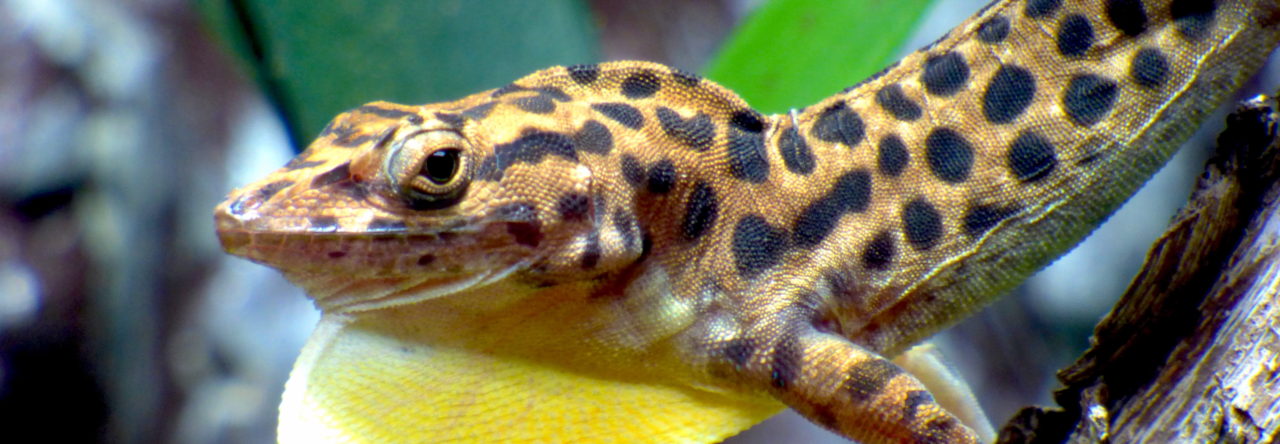The march of Anolis to 400 species continues with a paper by Kirsten Nicholson and Gunter Köhler describing a new species from Panama.Actually, according to the Reptile Database, there are already exactly 400 species! So this makes 401.
Previously, ten members of the pentaprion group were known, seven from Central America, three from South America.
 The new species, A. triumphalis (described under the name Norops triumphalis) has a large orange dewlap, thus distinguishing it from all other members of the group, which have a reddish-purple dewlap.*
The new species, A. triumphalis (described under the name Norops triumphalis) has a large orange dewlap, thus distinguishing it from all other members of the group, which have a reddish-purple dewlap.*
Anolis triumphalis is described from a single male that was captured crossing the road between pastures with tall grass and a fence composed of wooden fenceposts and living trees. As the authors note, pentaprion group anoles are very similar to West Indian twig anoles. This story is reminiscent of the rediscovery of another mainland twig anole, A. proboscis, found after forty years by a group of birdwatchers when a male was observed crossing a road in front of a mini-van. Why the twig anole crossed the road is clearly a question that will puzzle philosophers for years to come.
*The authors state that the large, orange dewlap doesn’t distinguish A. triumphalis from A. sulcifrons, but as far as I’m aware, the latter species has a red-purple dewlap like other pentaprion group members.
Here’s the abstract:
We describe the new species Norops triumphalis sp. nov. from Darién, Panama. Norops triumphalis differs from all congeners by having a combination of (1) smooth, bulging, subimbricate ventral scales; (2) a short tail, ratio tail length/SVL 1.54; (3) short hind legs, longest toe of adpressed hind leg reaching to ear opening, ratio shank length/SVL 0.24; (4) a lichenous body pattern; and (5) a very large yellowish orange dewlap in males. In external morphology, N. triumphalis is most similar to the species of the N. pentaprion group. Norops triumphalis differs from the other species in the N. pentaprion group, except N. sulcifrons, by having a very large orange male dewlap (vs. a large red or pink dewlap) and an unpigmented throat lining. Norops triumphalis differs from N. sulcifrons by having the supracaudal scales not forming a serrated crest (vs. a distinct serrated caudal crest present in N. sulcifrons), 4 supracaudal scales per segment (vs. 3 supra-caudal scales per segment in N. sulcifrons), greatly enlarged outer postmental scales, about four times the size of adjacent medial scales (vs. moderately enlarged outer postmental scales, about twice the size of adjacent medial scales, in N. sulcifrons), and no enlarged postcloacal scales in males (vs. a pair of moderately enlarged postcloacal scales present in male N. sulcifrons). We further provide a standardized description and illustrations of the holotype of N. sulcifrons.
- Evolution in Real Time on Lizard Island - March 23, 2025
- Spider Snags Adult Anolis osa - March 22, 2025
- An Homage to the Green Anoles of New Orleans - March 21, 2025



Claus Bo Petersen
Actually, there are now “only” 396 species: http://reptile-database.reptarium.cz/advanced_search?taxon=Dactyloidae&submit=Search
In addition to anoles, the list in your link includes some distantly related taxa (e.g., Crocodylus porosus).
Peter Uetz
Yes, that’s because “Anolis” is mentioned in the comments or elsewhere in those unrelated species accounts in the Reptile Database. There are 395 species of Anolis, including 42 species that currently have a total of 123 subspecies (on top of the nominate subspecies; just in case someone is inclined to elevate them to full species status 🙂